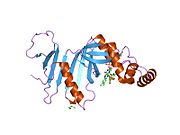Pyridoxine 5′-phosphate oxidase
| Pyridoxal 5′-phosphate synthase | |||||||||
|---|---|---|---|---|---|---|---|---|---|
ExPASy NiceZyme view | | ||||||||
| KEGG | KEGG entry | ||||||||
| MetaCyc | metabolic pathway | ||||||||
| PRIAM | profile | ||||||||
| PDB structures | RCSB PDB PDBe PDBsum | ||||||||
| Gene Ontology | AmiGO / QuickGO | ||||||||
| |||||||||
Pyridoxine 5′-phosphate oxidase is an
The active form of
Structure
Pyridoxine 5′-phosphate oxidase is a

Pathway
Pyridoxine 5′-phosphate oxidase is the enzyme that catalyzes the rate-limited step of the B6 metabolism pathway. Vitamin B6, which is also known as
Reactions
Pyridoxine 5′-phosphate oxidase catalyzes several reactions; the two most important are the deamination of pyridoxamine 5′-phosphate and the deamination of pyridoxine 5-phosphate, both of which are key intermediates in the metabolism of B6.[8] Pyridoxine 5′-phosphate oxidase's EC number is 1.4.3.5.[6]
- pyridoxamine 5′-phosphate +

- pyridoxine phosphate + O2 ⇌ H2O2 + pyridoxal phosphate

Pyridoxine 5′-phosphate oxidase also plays a role in nitrogen metabolism, converting amines to aldehydes and NH3 by the reaction:
- amine + H2O + O2 ⇌ aldehyde + NH3 + H2O2

Kinetics
In humans, the pyridoxine 5′-phosphate oxidase enzyme exhibits a low catalytic
Pyridoxine 5′-phosphate oxidase in different organisms
Pyridoxine 5′-phosphate oxidase has been highly conserved over time, as there are many similarities between the enzyme as it is found in humans and Escherichia coli. Although there is only 39% retention of amino acid sequence from the E. coli version of the enzyme to the human version, the sequences for the FMN binding site and the substrate active sites are among the very highly conserved portion. One of the key differences is that the human pyridoxine 5′-phosphate oxidase has a higher specificity for the pyridoxamine 5′-phosphate substrate, whereas the pyridoxine 5′-phosphate oxidase in E. coli has a higher specificity pyridoxal 5′-phosphate substrate.[9]
Clinical significance
Mutations of the PNPO gene may result in the development of pyridoxamine 5'-phosphate oxidase deficiency, a disease presenting soon after birth with seizures and subsequent encephalopathy.
References
- PMID 9601034.
- PMID 15182361.
- ^ a b "Entrez Gene: PNPO pyridoxamine 5'-phosphate oxidase".
- ^ a b "Vitamin B6". Retrieved 2007-06-03.
- ISBN 0-7167-4339-6.
- ^ a b Online Mendelian Inheritance in Man (OMIM): Pyridoxamine 5-Prime-Phosphate Oxidase; PNPO - 603287
- PMID 11786019.
- ^ "Vitamin B6 metabolism". Reference pathway. KEGG: Kyoto Encyclopedia of Genes and Genomes.
- ^ PMID 12824491.
Further reading
- Maruyama K, Sugano S (1994). "Oligo-capping: a simple method to replace the cap structure of eukaryotic mRNAs with oligoribonucleotides". Gene. 138 (1–2): 171–4. PMID 8125298.
- Suzuki Y, Yoshitomo-Nakagawa K, Maruyama K, et al. (1997). "Construction and characterization of a full length-enriched and a 5'-end-enriched cDNA library". Gene. 200 (1–2): 149–56. PMID 9373149.
- Strausberg RL, Feingold EA, Grouse LH, et al. (2003). "Generation and initial analysis of more than 15,000 full-length human and mouse cDNA sequences". Proc. Natl. Acad. Sci. U.S.A. 99 (26): 16899–903. PMID 12477932.
- Musayev FN, Di Salvo ML, Ko TP, et al. (2004). "Structure and properties of recombinant human pyridoxine 5′-phosphate oxidase". Protein Sci. 12 (7): 1455–63. PMID 12824491.
- Ota T, Suzuki Y, Nishikawa T, et al. (2004). "Complete sequencing and characterization of 21,243 full-length human cDNAs". Nat. Genet. 36 (1): 40–5. PMID 14702039.
- Gerhard DS, Wagner L, Feingold EA, et al. (2004). "The Status, Quality, and Expansion of the NIH Full-Length cDNA Project: The Mammalian Gene Collection (MGC)". Genome Res. 14 (10B): 2121–7. PMID 15489334.
- Mills PB, Surtees RA, Champion MP, et al. (2005). "Neonatal epileptic encephalopathy caused by mutations in the PNPO gene encoding pyridox(am)ine 5'-phosphate oxidase". Hum. Mol. Genet. 14 (8): 1077–86. PMID 15772097.
- Kimura K, Wakamatsu A, Suzuki Y, et al. (2006). "Diversification of transcriptional modulation: Large-scale identification and characterization of putative alternative promoters of human genes". Genome Res. 16 (1): 55–65. PMID 16344560.
External links
 Media related to Pyridoxine 5'-phosphate oxidase at Wikimedia Commons
Media related to Pyridoxine 5'-phosphate oxidase at Wikimedia Commons

